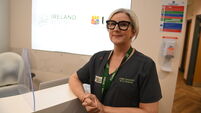Jennifer Horgan: Femtech has finally discovered the bleedin' obvious

A friend was once told by her young male GP that he's not 'great on women’s health'. She asked why he didn’t hang a ‘men’s clinic’ sign on his door. He looked confused as she explained that women make up half the human population, and so, women’s health is just health. File photo
. The title of a book I bought for a friend’s daughter this week. She bought it for mine a few years ago. I lost it of course, so I’ve purchased a return copy.
It’s a big deal — a girl getting her period. Providing them with basic information is a given. It amazes me how difficult such a given can seem, however, and how often female health is framed as a specialism.
A friend was once told by her young male GP that he's not “great on women’s health”. She asked why he didn’t hang a ‘men’s clinic’ sign on his door. He looked confused as she explained that women make up half the human population, and so, women’s health is just health.
The same friend got a diagnosis of endometriosis about five years ago. She’s 53 years old. The condition, affecting approximately 10% of women, has the potential to be hugely debilitating, as it has been for her.
The truth is that the neglect of women’s health, the health of every second person, is baked into medical science. To put this assertion into some kind of perspective we might consider the fact that magazine named the Q-Pad one of the best inventions of 2024.
The Q-pad, invented by the biotechnology research company Qvin, is a pad with a removable strip to collect menstrual blood samples for clinical tests. Women can now avoid painful, invasive procedures and simply bleed as they naturally do, to get long-awaited answers.
Qvin is one of several start-ups finally considering the diagnostic potential of period blood. NGJ is another. Unsurprisingly, these are mostly women-led initiatives.
Rather than celebrate Qvin’s landmark “discovery”, I (somewhat fittingly) see red. How has something so obvious and visible, something that has been so central to women’s lives been ignored for so long?
How is it that mothers are handing books on periods to their daughters in a world where it has taken until 2024 to get approval for something that sounds about as innovative as a sticking plaster?
The language describing these developments is astounding. Launching the menstruation science initiative earlier this year, the Massachusetts Institute of Technology (MIT) announced it as “frontier science”. The National Library of Medicine states (seemingly without irony) that menstrual blood, has “emerged” as a valuable source of health information.
Emerged — as if previously hidden from view. Not from women’s view, certainly.
If we’re discussing visibility, we might consider how sperm has been treated over the last 300 years or so. I first saw a microscopic close-up of sperm watching in 1990. I can’t remember ever not knowing about sperm.
It seems about right to me that the scientific world began to analyse sperm around the same time as it began to study space. Louis Theroux used the term ‘crotch-rock’ to describe 1970s music in his podcast last week. We might similarly refer to medical science as ‘crotch-science’.
Men mused about sperm long before they studied it of course, just as they did space. The Roman poet and philosopher Titus Lucretius Carus figured that sperm production was part of a natural physical process tied to “the flow of atoms”.
The ancient Greeks and Romans also spent time gazing to the stars and planets, naming them, with Ptolemy, the Greco-Egyptian scholar, arguing that Earth was a sphere in the centre of the universe.
Around the 17th century, things got a bit clearer on both fronts. Galileo publicly supported Copernicus, the theory that the Sun was at the centre of the solar system. In the same century, the microscope was pointed towards the penis, and in 1677, Antonie van Leeuwenhoek observed spermatozoa (semen animals) describing sperm tails swaying in a symmetric pattern, like “that of a snake or an eel”.
Viagra, taken to treat erectile dysfunction, appeared on the market in the same century (the 20th) as human ovulation was first properly studied and understood. Indeed, the human ovum was not properly recorded until 1827, long after human sperm.
Crotch-science deserves a bit of slack here — the female egg is an internal occurrence — so not as easily examined and analysed.
Which brings us back to menstrual blood. Why was that not analysed in the same way as sperm? Why has it taken until 2024? It’s odd, right?
Certainly, considering menstrual blood was examined to monitor female health as early as the 5th and 4th century BC, when the body was assessed in terms of its various fluids. Not just ones we'd recognize, like blood and phlegm, but also yellow bile and black bile. Menstrual fluid was inspected for evidence of these. If black, there was too much bile. If white, there was too much phlegm.
Somewhere along the way this medical interest in periods disappeared.
Perhaps the medieval book (On Women's Secrets) gives us some clue as to why — here the womb is described as being like a sewer situated in the middle of town where all waste materials run together.
The neglect of periods is probably also related to the fact that in the major monotheistic religions of the West (Judaism, Christianity and Islam), the male semen was viewed as the primary component in reproduction. Crotch-science. Everywhere. So, science is having to catch up.
Qvin’s co-founder and CEO, Dr Sara Naseri, tells Femtech World: “We’re constantly getting information about what is going on in our body, we’re tracking our steps, our sleep, our pulse, our sweat and yet women bleed every month and we’d never thought about how we could make use of that.”
“When we first started, labs refused to run samples of menstrual blood, so we had to build our own clinical laboratory,” she said.
Similarly, Renate van der Molen, an immunologist at Radboud University medical centre, who studies menstrual blood to detect gynecological conditions, says: “It is thought of as dirty, a bit stinky and useless … People hesitate to give a sample.”
No such disgust with human urine and poo samples. No, and an absolute, uninterrupted fascination with human sperm. This ‘ick’ factor sits at the centre of crotch-science — and ultimately it is just another way in which we are harming if not killing women.
To end on a positive note, however, the current focus on menstrual blood may provide real answers for women at last. Cervical cancer, the fourth most common cancer in women, may be detected more easily.
The Research OutSmarts Endometriosis (ROSE) study is analysing period blood to specifically tackle endometriosis, my friend’s condition.
It’s just hard to celebrate something that should have happened long ago. Long before tech billionaires reached the zenith of crotch-science by sending their penis rockets into space.
Medical science has been orbiting men’s crotches for centuries. It’s upsetting to think we’re only just realising that women have crotches too.















